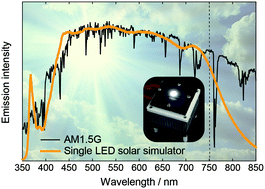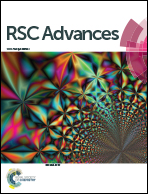Single-LED solar simulator for amorphous Si and dye-sensitized solar cells†
Abstract
An optimal combination of phosphors that simulates the solar spectrum under excitation at 365 nm has been revealed. CsVO3 and Zn3V2O8 vanadate phosphors that have broadband luminescence, Eu2+/Mn2+-doped silicates and aluminosilicates, and Fe2+-doped Li gallate were investigated as luminescence sources. The mixed phosphor powders had an internal quantum efficiency of 29.2%, a high color rendering index of 99, and a correlated color temperature of 5645 K. We fabricated a prototype LED solar simulator consisting of the optimized phosphor powder mixture embedded in resin on a silica glass substrate, and one high-power UV light-emitting diode (LED) with an emission wavelength of 365 nm. Our simulator achieved a Class A spectral match with the AM1.5G solar spectrum in the JIS C 8933 standard. An irradiance of 100 mW cm−2 was measured at a forward driving current of 700 mA for the UV LED. This system functioned well as a solar simulator for solar cell testing. The I–V curves of a Si photodiode calibrated as an amorphous Si solar cell and of a TiO2 dye-sensitized solar cell were very similar to the I–V curves measured under a conventional Xe lamp solar simulator.


 Please wait while we load your content...
Please wait while we load your content...